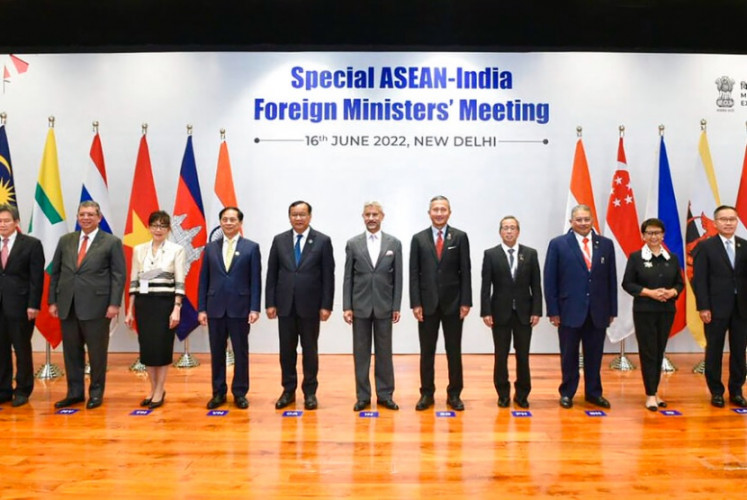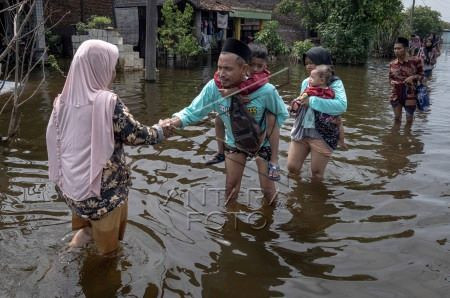Women, disasters and climate change
In his speech in 2009, UN Secretary-General Ban Ki-moon said climate change affected people of all ages and gender albeit in different scales and intensity. However, the most vulnerable are the poor, while women are disproportionately affected as compared with men, with a ratio of 4:1. According to the World Bank ( 2008 ), 61 percent of victims from the Myanmar hurricane were female, 80 percent from the Aceh tsunami and 67 percent from Hurricane Gorky in Bangladesh.
Change Size
 One of nine female farmers of Mount Kendeng, Rembang regency, Central Java protest against cement plants developments in their area by cementing their feet in front of the State Palace, Jakarta, on Wednesday, 13 April 2016. They demanded to meet with the President to voice their concerns over the plants' construction that would harm the environment and threaten their livelihoods as farmers. (The Jakarta Post/Seto Wardhana)
One of nine female farmers of Mount Kendeng, Rembang regency, Central Java protest against cement plants developments in their area by cementing their feet in front of the State Palace, Jakarta, on Wednesday, 13 April 2016. They demanded to meet with the President to voice their concerns over the plants' construction that would harm the environment and threaten their livelihoods as farmers. (The Jakarta Post/Seto Wardhana)
T
he floods and landslides that recently struck several parts of Indonesia emphasize the fact that climate change is no longer just a prediction, but is inevitable. From the many natural disasters in the past three years, National Disaster Mitigation Agency (BNPB) data show that 95 percent of 1,053 incidents in 2016 were related to hydrometeorological causes such as floods and landslides, which killed 157 and affected around 1.7 million people.
In his speech in 2009, UN Secretary-General Ban Ki-moon said climate change affected people of all ages and gender albeit in different scales and intensity. However, the most vulnerable are the poor, while women are disproportionately affected as compared with men, with a ratio of 4:1. According to the World Bank ( 2008 ), 61 percent of victims from the Myanmar hurricane were female, 80 percent from the Aceh tsunami and 67 percent from Hurricane Gorky in Bangladesh.
Women also endure greater ongoing suffering from the impacts of climate change. For example, failed crops causing food scarcity may further result in a sharp increase in malnutrition among women and girls — as many traditions prioritize food for men and boys as the breadwinners of the family. During long droughts, women must walk as far as 10 kilometers just to fetch a bucket of water for their families.
These circumstances may lead to the misperception that women are more vulnerable to the impacts of disasters because of their weak physical characteristics; in reality, it is gender inequality that contributes to the high proportion of women’s suffering amid disasters.
A study conducted by the London School of Economics on natural disasters in 141 countries in 1981-2002 concluded that in situations where women had no social or economic rights, the number of women victims tended to be higher than men. The study further found that once these rights were balanced between the two genders, the proportion of fatalities between men and women tended to be equal.
Another factor is that women are seldom involved in decisionmaking processes to access and utilize land and livelihood resources, which furthers their vulnerability to the impacts of natural disasters.
Ironically, although women are the most vulnerable, they are not equipped with sufficient knowledge or skills to prepare themselves to face the impacts of climate change. Various policies on climate change still embed a gender bias.
Policies on information access related to climate change should apply different strategies for women in adapting to climate change.
Women lack access to information on the impacts of climate change and related policies. If the information is provided in the form of brochures, leaflets or other print media, the government apparently does not take into consideration the fact that the literacy rate of women remains low. The illiteracy rate of women aged above 10 is double that of men. The higher the illiteracy rate and the greater the difficulties in accessing information, the greater women’s vulnerability.
On the other hand, the successful initiatives of women in applying their knowledge and skills in adapting to climate change are not necessarily acknowledged.
There is only minimal involvement from women in discussions and policy development on climate issues, from the community level up to the international level.
Meanwhile, women themselves often lack confidence, given limits on freedom of expression.
With high risk of natural disasters and climate change, Indonesia should empower women to play a more significant role in adapting to climate change. This could start with collecting gender-segregated data that includes data on the people’s level of understanding of climate change, their various concerns, the initiatives taken and other relevant issues.
With this data pool, issues related to disaster mitigation and adaptation for both men and women could be addressed. It would be naive to develop policies and strategies without valid data.
Second, women should be involved in developing policies and decision making on climate issues. Information on climate issues should be accessible particularly to those in rural areas that depend on agriculture and forest products as their source of livelihood, in which the climate is an important factor in determining successful harvest or crop failure.
Third, through cultural reconstruction in the community, women should have equal rights to education and healthcare and be provided with the skills to survive independently. This would encourage women not only to help themselves but also to contribute to their society in mitigating the impacts of disasters and climate change.
With this drive, women can become assets rather than a burden in any disaster or climate change mitigation efforts. As Mary Robinson and Wangari Maathai stated in the Huffington Post in 2010, “The battle to protect the environment is not solely about technological innovation — it is also about empowering women and their communities to hold their governments accountable for results.”
***
The writer is knowledge management coordinator for the USAID LESTARI project.
---------------
We are looking for information, opinions, and in-depth analysis from experts or scholars in a variety of fields. We choose articles based on facts or opinions about general news, as well as quality analysis and commentary about Indonesia or international events. Send your piece to community@jakpost.com.








